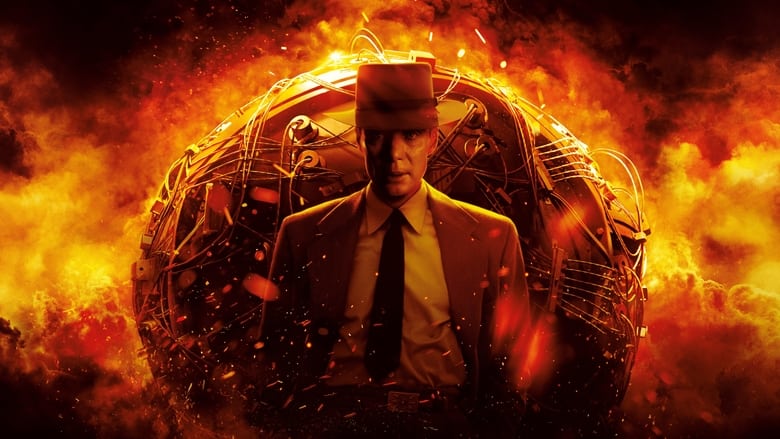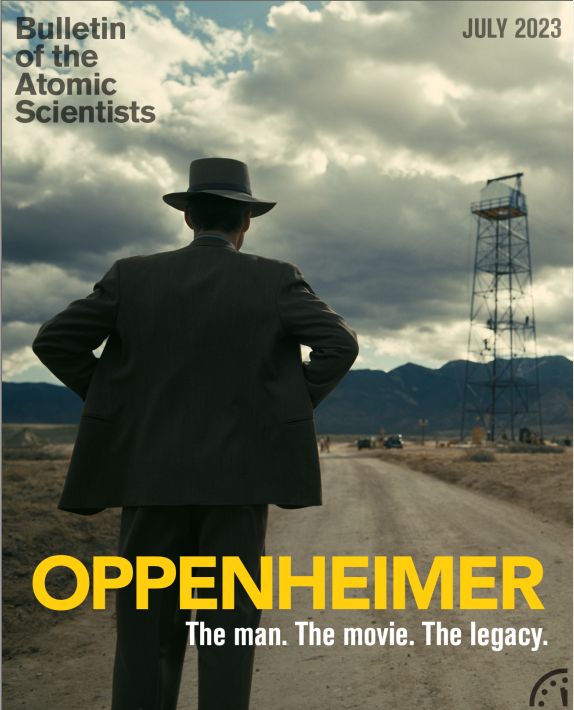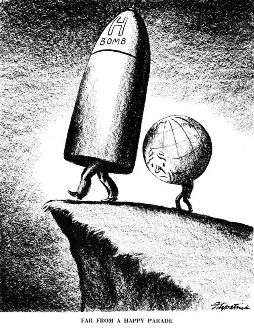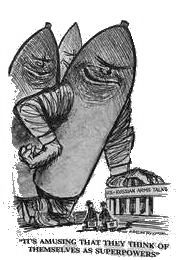Christopher Nolan’s new “chillingly brilliant” movie, Oppenheimer (2023), provides the opportunity to reconsider the Doomsday Machine on the 78th anniversary of Hiroshima. A plea in the name of Islam and of Sufism.
For our earlier articles on the subject, see here, here and here.

... the physicists have known sin; and this is a knowledge which they cannot lose.
—J. Robert Oppenheimer, 1947
There are no ifs, ands or buts, no question about it: Weapons of Mass Destruction (WMDs), and more specifically (thermo)nuclear weapons, will put an end to all life on the third planet from the star called Sol. Anyone with enough information, plus the sense God gave a cockroach, can see this clear as day. The only hope is the abolition of all WMDs.
Christopher Nolan considers Julius Robert Oppenheimer the most important human being who ever lived. And at least in terms of Doomsday, he may be absolutely right. Though there’s a long list of names appended to that. Here is another vindication of the fact that abstract thoughts have consequences in real life: when you look at the equation E = mc2, can you see Hiroshima and Nagasaki inside? You can’t, but nevertheless it’s there. And so is Doomsday itself.
What Rough Beast Slouches Towards Los Alamos...

Based on the in-depth study by Kai Bird and Martin Sherwin in American Prometheus: The Triumph and Tragedy of J. Robert Oppenheimer (2005), Nolan traces the career of his subject from the early days through to the first atomic bomb explosion and beyond. The tension keeps building, never refusing to let up until the Trinity test. The partly fictionalized TV Series Manhattan (2014–2015) took a closer look at the goings-on at Los Alamos during that gestation period. Later on, Oppenheimer would summarize how the scientists got caught up in the heady rush, the exhilaration, of discovery: “When you see something that is technically sweet, you go ahead and do it and you argue about what to do about it only after you have had your technical success. That is the way it was with the atomic bomb.”
Oppenheimer finally finds himself in the unenviable position of Dr. Frankenstein: he discovers he has midwifed a monster into existence that cannot be destroyed. He feels both pride and regret about his brainchild. That, and what came next, was his tragedy. For opposing the hydrogen bomb, which is a thousand times worse than the atomic bomb, he was hauled before a government committee and crucified. The names of the petty actors are known but irrelevant: what counts is that they wanted to make an example of him. His ostracization and the revoking of his security clearance sent a warning from the military-political juggernaut to all scientists: that their peace efforts to bring the atomic genie under control would not be tolerated. After that, all the moral qualms of the scientific community were stifled, and any dissent could be couched only in terms of technical reservations. The greed of the Base Self for quasi-godlike power was insatiable, even as it was hidden under the excuse of “if the enemy is going to have it, we have to have it too,” and hydrogen bombs were being churned out by the dozen like sausages from a meat factory.
 Perhaps the most important revelation from Ellsberg’s book is that it explodes the myth that the President of the USA will be the one and only person to decide the launch of nuclear weapons. The problem here is the “decapitation strike:” what if all the central decision-makers have been obliterated? The solution is to delegate responsibility downwards, to the theater commanders, but by the sheer force of the logic, it devolves all the way down to individual bomber pilots or ICBM launch lieutenants. And the same goes for the Russians: their “Dead Hand” response has been known for years, in which an automated retaliation can be activated even if there’s no one left to decide.The Aftermath
Perhaps the most important revelation from Ellsberg’s book is that it explodes the myth that the President of the USA will be the one and only person to decide the launch of nuclear weapons. The problem here is the “decapitation strike:” what if all the central decision-makers have been obliterated? The solution is to delegate responsibility downwards, to the theater commanders, but by the sheer force of the logic, it devolves all the way down to individual bomber pilots or ICBM launch lieutenants. And the same goes for the Russians: their “Dead Hand” response has been known for years, in which an automated retaliation can be activated even if there’s no one left to decide.The Aftermath
Fred Kaplan’s The Bomb (2020) chronicles the major players of that period and its aftermath: Presidents, Generals, and the Secret History of Nuclear War, as the subtitle has it. According to one review: “Overall, the book provides a devastating portrayal of the insanity of the nuclear targeting process. In one case, 69 warheads were targeted on a single Soviet anti-ballistic missile site.” Ultimately, no civilian administration, no matter how opposed to the use of nuclear weapons, ever managed to dig itself out of the quandary they posed.
In The Doomsday Machine: Confessions of a Nuclear War Planner (2017), the late Daniel Ellsberg outlined the thinking going on in the minds of those who plan such things. A Doomsday Machine, of which there are at least two on Earth, is defined by Ellsberg as a “system of men, machines, electronics, communications, institutions, plans, [bombs, missiles, submarines, etc., which would] bring about the global destruction of civilization and of nearly all human life on earth” (p339). Working at RAND Corp. during the critical years when the thermonuclear weapons industry was mushrooming, Ellsberg had a front-row seat into the mental machinations of his colleagues.
When Ellsberg learned that the Joint Chiefs of Staff projected a death toll of 600 million (when the Earth’s population was 3 billion), he was incredulous. To him, this meant 100 Holocausts, and it didn’t include numbers for the enemy’s retaliation, either. He thought, “This is the most evil plan that has ever existed. It’s insane.” What’s more, even the explosion of 100 nuclear weapons would be enough to hurl the planet into a nuclear winter, as the dust and debris lifted into the atmosphere blotted out the sun. Most ominously, it emerges that all the efforts of civilian nuclear planners have had scant effect on military plans. Ellsberg also says that the nuclear powers used their weapons passively, for blackmail and bullying other nations into submission: it was like placing a loaded gun on the table without saying anything.
The Pitiless Generation
Master Kayhan said, in effect: “A generation will come that is devoid of mercy. After that, a human’s life will not be worth a cat’s. That is the generation that will do it.”
What will happen? Well, you’ve probably heard how a chain reaction takes place: one neutron gives rise to two neutrons, two give rise to four, four to eight, and so on, until by a certain number of generations, presto! you have an explosion. And in the same way, behold: I give you the chain reaction of the chain reaction. One nation will bomb another, two or three nations will strike back, perhaps five will retaliate, more will counter-retaliate, until in a small number of steps, the whole earth will be engulfed in the conflagration. Nuclear escalation will proceed to its inevitable conclusion. There will be no escape. The only escape is now, by dismantling this infernal contraption while we still can.
The initial impact of thermo/nuclear weapons was so great that human minds recoiled in horror, preferring to forget rather than face the reality squarely and take the necessary precautions. Because T/N bombs confer godlike power on their owner, they are Tolkien’s Ring of Sauron, the Ring of Power, the allure of which no human leader can resist. Yet that allure must be resisted and must be overcome.
Just Abolish Them
Today, we have become inured to the effects of T/N weapons. Familiarity breeds contempt. But we only delude ourselves. To anchor this article to current debates, people are acting as if thermonuclear war is merely an extension of conventional warfare. It is not. Check out the tone of this ad: “If a Bomb falls near you, stay at home. Wait for government announcements on TV.” Really! If a Bomb falls near you, you, your home, your TV, and most probably the government will all have been vaporized already. People who foster such thinking have no idea whatsoever of the gravity of the situation.
One of the ways T/N weapons kill is setting living beings spontaneously on fire. Here, all I can do is recall the words of the Prophet: “Don’t kill any living thing by burning it.”
So, to put a little perspective on this, a stick of dynamite is to a firecracker as a bomb is to a stick of dynamite, a bomb is to a stick of dynamite as an atomic bomb is to a bomb, and an atomic bomb is to a bomb as a hydrogen bomb is to an atomic bomb. You can assume a factor of 1,000 in each case. They don’t describe the brightness of an atomic explosion as “many times that of the noonday sun” for nothing.
The greatest secret of the atomic bomb—or the hydrogen bomb—was not this or that technical hurdle, or fine theoretical points of high-tech physics. It was the knowledge that it can be done. Once the first Bomb was exploded, the secret was out. After that, well, human ingenuity didn’t, and doesn’t, end with the people who made the first discovery. Other minds were equally capable of building a bomb. And that’s where we have been ever since. Once the toothpaste is out of the tube, once the nuclear genie is out of the bottle, you can’t put it back in again. All efforts to limit the Nuclear Club will fail, for the simple reason that no one will feel safe until they have the Bomb too. It’s really elementary: Japan, which didn’t have the Bomb, got nuked; North Korea, which does have the Bomb, doesn’t. What would you conclude from that? For self-preservation if for no other reason, everyone who can get the Bomb, will. And so, the sooner we abolish WMDs the better, for the process will become increasingly more unstoppable.
What kind of mentality can wish for the destruction of all life? We may pretend that this is due to indifference. But that indifference is only a mask for repressed hate and rage. God’s command to us is to “Love one another.” If we do not succeed in doing that, all our lives will be forfeit.

Cartoons by Herbert J. Block (“Herblock”).